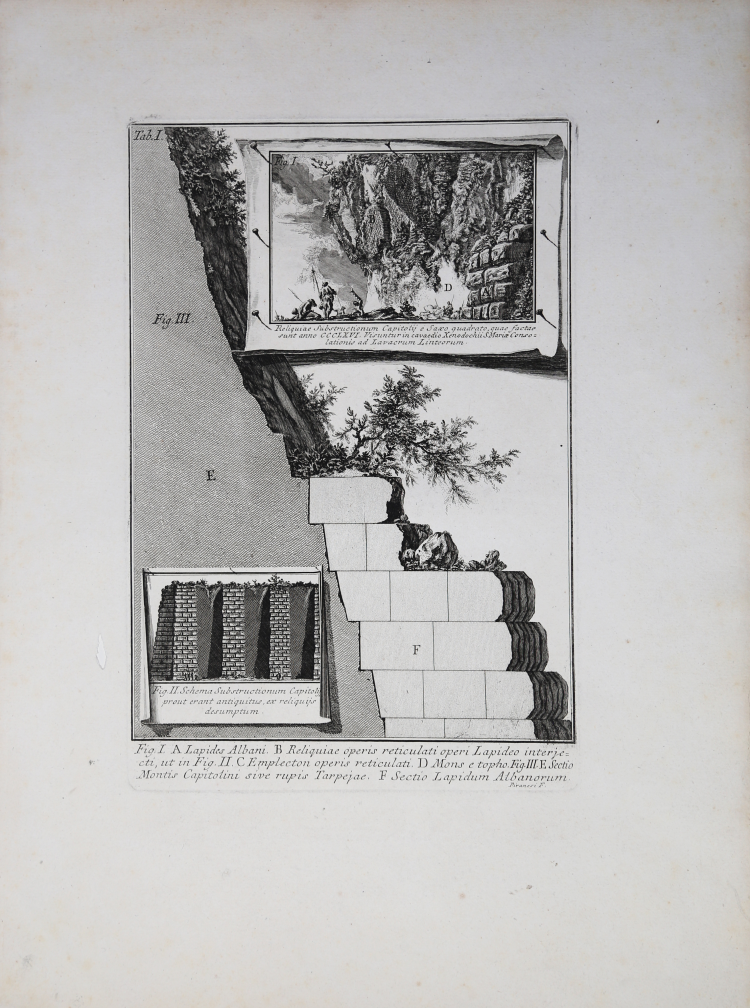



| Reference: | S41737.12 |
| Author | Giovan Battista PIRANESI |
| Year: | 1761 |
| Printed: | Rome |
| Measures: | 240 x 355 mm |


| Reference: | S41737.12 |
| Author | Giovan Battista PIRANESI |
| Year: | 1761 |
| Printed: | Rome |
| Measures: | 240 x 355 mm |
Copperplate, signed at the bottom.
From Della Magnificenza e d'Architettura de' Romani, published in Rome 1761.
A fine impression, on laid paper, with full margins and perfect condition.
Giovanni Battista Piranesi's 'Della Magnificenza e d'Architettura de' Romani' was a contribution to the continuing debate as to whether Greek art and architecture was superior to that of Rome. In the 1750s, intellectual circles were increasingly in favor of Greece. Piranesi had completed 'Le Antichità Romane' in 1756-1757 and when Julien-David Le Roy published 'Les ruines des plus beaux monuments de la Grece' in 1758, Piranesi responded with Della Magnificenza. In his publication Piranesi argues in favor of Roman architectural ornament by drawing comparisons with specific examples from Le Roy's text. This is why many of the plates in this volume contain visual and text references to Le Roy.
Also in this volume is Piranesi's response to the French critic Pierre-Jean Mariette (1694-1774). On November 4 1764, Mariette published a letter in the Gazette Littéraire de l'Europe, in which he argues against the ideas expressed in Della Magnificenza. Mariette considered Roman art to have Greek origins. Piranesi's response to his views was published in 1765, in which writing in the third person, he defends the artistic originality of the Romans.
Giovan Battista PIRANESI (Mogliano Veneto 1720 - Roma 1778)
|
Italian etcher, engraver, designer, architect, archaeologist and theorist. He is considered one of the supreme exponents of topographical engraving, but his lifelong preoccupation with architecture was fundamental to his art. Although few of his architectural designs were executed, he had a seminal influence on European Neo-classicism through personal contacts with architects, patrons and visiting artists in Rome over the course of nearly four decades. His prolific output of etched plates, which combined remarkable flights of imagination with a strongly practical understanding of ancient Roman technology, fostered a new and lasting perception of antiquity. He was also a designer of festival structures and stage sets, interior decoration and furniture, as well as a restorer of antiquities. The interaction of this rare combination of activities led him to highly original concepts of design, which were advocated in a body of influential theoretical writings. The ultimate legacy of his unique vision of Roman civilization was an imaginative interpretation and re-creation of the past, which inspired writers and poets as much as artists and designers.
|
Giovan Battista PIRANESI (Mogliano Veneto 1720 - Roma 1778)
|
Italian etcher, engraver, designer, architect, archaeologist and theorist. He is considered one of the supreme exponents of topographical engraving, but his lifelong preoccupation with architecture was fundamental to his art. Although few of his architectural designs were executed, he had a seminal influence on European Neo-classicism through personal contacts with architects, patrons and visiting artists in Rome over the course of nearly four decades. His prolific output of etched plates, which combined remarkable flights of imagination with a strongly practical understanding of ancient Roman technology, fostered a new and lasting perception of antiquity. He was also a designer of festival structures and stage sets, interior decoration and furniture, as well as a restorer of antiquities. The interaction of this rare combination of activities led him to highly original concepts of design, which were advocated in a body of influential theoretical writings. The ultimate legacy of his unique vision of Roman civilization was an imaginative interpretation and re-creation of the past, which inspired writers and poets as much as artists and designers.
|